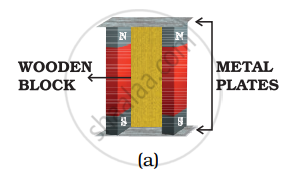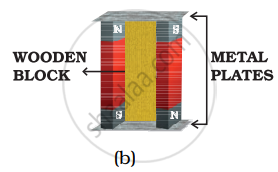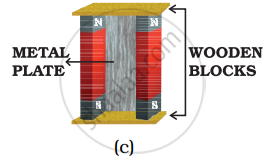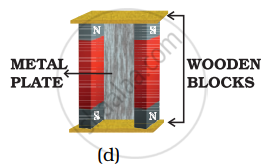Advertisements
Online Mock Tests
Chapters
2: Components of Food
3: Fibre to Fabric
4: Sorting Materials and Groups
5: Separation of Substances
6: Changes Around Us
7: Getting to Know Plants
8: Body Movement
9: The Living Organisms and their Surroundings
10: Motion and Measurement of Distances
11: Light
12: Electricity and Circuits
▶ 13: Fun with Magnets
14: Water
15: Air Around Us
16: Garbage in, Garbage out
![NCERT Exemplar solutions for Science [English] Class 6 chapter 13 - Fun with Magnets NCERT Exemplar solutions for Science [English] Class 6 chapter 13 - Fun with Magnets - Shaalaa.com](/images/science-english-class-6_6:5f2b1b2038084cf381bfa42c826a928c.jpg)
Advertisements
Solutions for Chapter 13: Fun with Magnets
Below listed, you can find solutions for Chapter 13 of CBSE NCERT Exemplar for Science [English] Class 6.
NCERT Exemplar solutions for Science [English] Class 6 13 Fun with Magnets Multiple Choice Questions [Pages 79 - 81]
Observe the pictures A and B given in Fig. 13.1 carefully.

Which of the following statement is correct for the above given pictures?
In A, cars 1 and 2 will come closer and in B, cars 3 and 4 will come closer
In A, cars 1 and 2 will move away from each other and in B, cars 3 and 4 will move away.
In A, cars 1 and 2 will move away and in B, 3 and 4 will come closer to each other.
In A, cars 1 and 2 will come closer to each other and in B, 3 and 4 will move away from each other.
The arrangement to store two magnets is shown by figures (a), (b), (c) and (d) in Fig. 13.2. Which one of them is the correct arrangement?
Three magnets A, B, and C were dipped one by one in a heap of iron filing. Fig. 13.3 shows the amount of iron filings sticking to them.
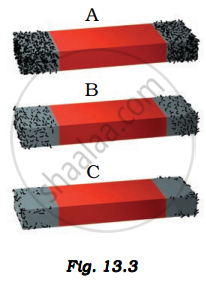
The strength of these magnets will be
A > B > C
A < B < C
A = B = C
A < B < C
North pole of a magnet can be identified by
Another magnet having its poles marked as North pole and South pole.
Another magnet no matter whether the poles are marked or not.
Using an iron bar.
Using iron filings.
A bar magnet is immersed in a heap of iron filings and pulled out. The amount of iron filling clinging to the
North pole is almost equal to the south pole.
North pole is much more than the south pole.
North pole is much less than the south pole.
Magnet will be same all along its length
NCERT Exemplar solutions for Science [English] Class 6 13 Fun with Magnets Very Short Answer Questions [Pages 81 - 82]
Fill in the blanks
When a bar magnet is broken; each of the broken parts will have ______ pole/poles.
In a bar magnet, magnetic attraction is ______ near its ends.
Paheli and her friends were decorating the class bulletin board. She dropped the box of stainless steel pins by mistake. She tried to collect the pins using a magnet. She could not succeed. What could be the reason for this?
How will you test that ‘tea dust’ is not adulterated with iron powder?
Boojho dipped a bar magnet in a heap of iron filings and pulled it out. He found that iron filings got stuck to the magnet as shown in Fig. 13.4
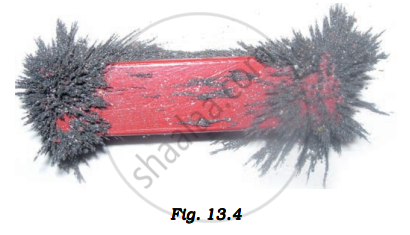
- Which regions of the magnet have more iron filings sticking to it?
- What are these regions called?
Four identical iron bars were dipped in a heap of iron filings one by one. Fig. 13.5 shows the amount of iron filings sticking to each of them.
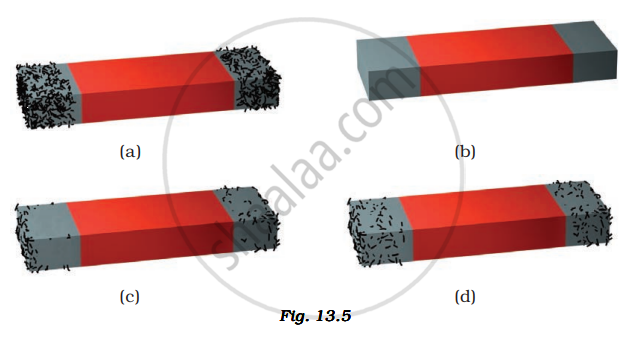
Which of the iron bar is likely to be the strongest magnet?
NCERT Exemplar solutions for Science [English] Class 6 13 Fun with Magnets Short Answer Questions [Pages 82 - 83]
Four identical iron bars were dipped in a heap of iron filings one by one. Fig. 13.5 shows the amount of iron filings sticking to each of them.

Which of the iron bars is not a magnet? Justify your answer.
A toy car has a bar magnet laid hidden inside its body along its length. Using another magnet how will you find out which pole of the magnet is facing the front of the car?
Match Column I with Column II (One option of A can match with more than one option of B)
| Column 1 | Column II | ||
| (a) | Magnet attracts | (i) | rests along a particular direction |
| (b) | Magnet can be repelled | (ii) | iron |
| (c) | Magnet if suspended freely | (iii) | another magnet |
| (d) | Poles of the magnet can be identified by | (iv) | iron filings |
You are provided with two identical metal bars. One out of the two is a magnet. Suggest two ways to identify the magnet.
NCERT Exemplar solutions for Science [English] Class 6 13 Fun with Magnets Long Answer Questions [Pages 83 - 84]
Three identical iron bars are kept on a table. Two out of three bars are magnets. In one of the magnet the North-South poles are marked. How will you find out which of the other two bars is a magnet? Identify the poles of this magnet.
Describe the steps involved in magnetising an iron strip with the help of a magnet.
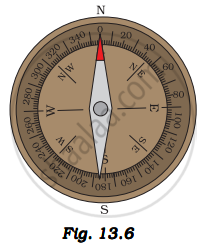
Fig. 13.6 shows a magnetic campass. What will happen to the position of its needle if you bring a bar magnet near it? Draw a diagram to show the effect on the needle on bringing the bar magnet near it. Also draw the diagram to show the effect when the other end of the bar magnet is brought near it.
Suggest an activity to prepare a magnetic compass by using an iron needle and a bar magnet.
Boojho kept a magnet close to an ordinary iron bar. He observed that the iron bar attracts a pin as shown in Fig. 13.7.

What inference could he draw from this observation? Explain.
A bar magnet is cut into two pieces A and B, from the middle, as shown in Fig. 13.8.

Will the two pieces act as individual magnets? Mark the poles of these two pieces. Suggest an activity to verify your answer.
Suggest an arrangement to store a U shaped magnet. How is this different from storing a pair of bar magnets?
Solutions for 13: Fun with Magnets
![NCERT Exemplar solutions for Science [English] Class 6 chapter 13 - Fun with Magnets NCERT Exemplar solutions for Science [English] Class 6 chapter 13 - Fun with Magnets - Shaalaa.com](/images/science-english-class-6_6:5f2b1b2038084cf381bfa42c826a928c.jpg)
NCERT Exemplar solutions for Science [English] Class 6 chapter 13 - Fun with Magnets
Shaalaa.com has the CBSE Mathematics Science [English] Class 6 CBSE solutions in a manner that help students grasp basic concepts better and faster. The detailed, step-by-step solutions will help you understand the concepts better and clarify any confusion. NCERT Exemplar solutions for Mathematics Science [English] Class 6 CBSE 13 (Fun with Magnets) include all questions with answers and detailed explanations. This will clear students' doubts about questions and improve their application skills while preparing for board exams.
Further, we at Shaalaa.com provide such solutions so students can prepare for written exams. NCERT Exemplar textbook solutions can be a core help for self-study and provide excellent self-help guidance for students.
Concepts covered in Science [English] Class 6 chapter 13 Fun with Magnets are Magnet, Uses of Magnets, Discovery of Magnets, Classification of Magnets, Magnetic and Non-magnetic Materials, Magnetic Pole, Finding Directions with a Magnet, Making a Magnet, Magnetic Properties, Demagnetization of a Magnet.
Using NCERT Exemplar Science [English] Class 6 solutions Fun with Magnets exercise by students is an easy way to prepare for the exams, as they involve solutions arranged chapter-wise and also page-wise. The questions involved in NCERT Exemplar Solutions are essential questions that can be asked in the final exam. Maximum CBSE Science [English] Class 6 students prefer NCERT Exemplar Textbook Solutions to score more in exams.
Get the free view of Chapter 13, Fun with Magnets Science [English] Class 6 additional questions for Mathematics Science [English] Class 6 CBSE, and you can use Shaalaa.com to keep it handy for your exam preparation.
